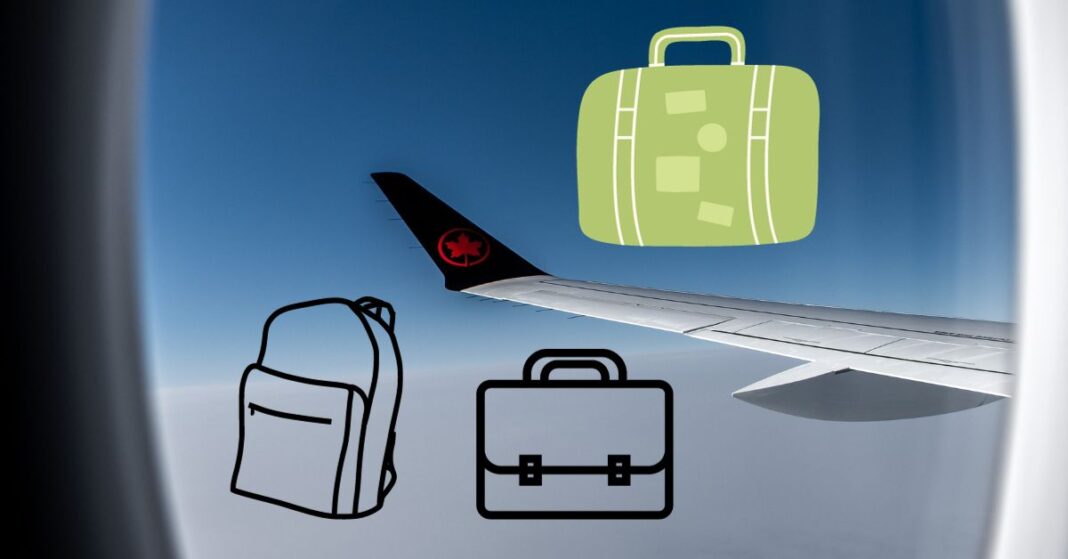Welcome to our guide on “Air Canada Carry-on Size”! Navigating airline regulations is crucial for a smooth travel experience.
In this blog, we’ll unravel the specifics of Air Canada’s carry-on size allowances, covering everything you need to know about dimensions, weight limits, and the types of items you can bring on board.
Whether you’re a seasoned traveler or a first-time flyer, let’s ensure you pack smartly and stress-free with Air Canada.
Table of Contents
Air Canada’s Carry On baggage policy
Whether you’re exploring Canada’s captivating landscapes, heading down to sunny Mexico, or flying across the Atlantic for European elegance, understanding your airline’s policy about carry-on baggage is crucial — it’s all part of the grand adventure! So, fellow wanderers, here lies the treasure map to your luggage-related solutions.
Tip 1: Size Matters!
Air Canada offers its passengers the liberty to carry one classic piece of luggage and one personal article on board. However, as any experienced traveler knows, there are certain dimensions to respect. For the standard article, make sure it doesn’t exceed 23 x 40 x 55 cm (9 x 15.5 x 21.5 in).
Your personal item, preferably a laptop bag or a briefcase, should be no larger than 16 x 33 x 43 cm (6 x 13 x 17 in). These dimensions include handles and wheels, so measure carefully to ensure a smooth journey.
Tip 2: Weigh It Out!
While many airlines enforce weight constraints on carry-on playmates, Air Canada dances to a different tune. The cosmic news is, there is no official weight limit for your carry-on baggage on most flights. However, they want you to be able to store it overhead or under your seat, so, use common sense when finalizing your baggage – it should be light enough for you to lift.
Tip 3: Restricted Items.
Air Canada, like any airline, does establish boundaries when it comes to what you can bring on board. Usual suspects like firearms, explosives, and pepper spray make the no-fly list, as expected. Other items like lithium batteries and e-cigarettes can only be packed in carry-on. Always make certain to check the list of restricted items on Air Canada’s official web page before you start packing.
Tip 4: Musical Instruments.
Some souls can’t bear being apart from their musical companions, and that’s perfectly acceptable with Air Canada. Small musical instruments can be counted as your standard carry-on or personal article, given they meet the size and weight requirements. For larger instruments like cellos, you can buy an extra seat. To guarantee their safe passage, take advantage of Air Canada’s official policy on musical instruments.
As any curious wanderer knows, effective packing is instrumental in creating a travel story that sings. Keep these tips in mind, and embark on your Air Canada journey with confidence and ease. It’s a grand world out there, waiting to be discovered – and what better way to greet it than with the freedom that comes from savvy packing? Navigate the blue skies – the world is your canvas and Air Canada is here to elevate your travel experience!
Packing within dimension limits
Discovering mesmerizing locales, harnessing new languages, tasting exotic delicacies – all part of the enthralling ride that is globe-trotting. But amidst all the thrill and excitement, there’s one task that many dread: packing. Yes, efficiently fitting life into a bag isn’t exactly the most exciting part of the journey, but it sure is a quintessential one.
Enhancing the travel experience is all about efficiency on the move, and this includes fulfilling Air Canada’s carry-on specifications. You’ve been introduced to Air Canada’s carry-on policies, so let’s now delve deeper and explore ways to pack that perfectly sized bag with all you need.
Tip 5: Stick to the Essentials
Start by distinguishing between your wants and needs on this trip. Carry only what is absolutely necessary; in this mindful selection lies the key to packing mastery. One might be tempted by the lack of structured weight constraints, but don’t fall into the trap – lightweight and versatile items can be real game-changers.
Tip 6: Space Optimization with Packing Cubes
Invest in compression packing cubes. They don’t merely keep your bag organized, but also work wonders to compress clothes and save space. Roll instead of folding clothes and maximize your carry-on space.
Tip 7: Make Use of Your Personal Article
The ‘Personal Article’ allowance is a gem. This could be a small backpack, laptop bag or purse and should fit under the seat in front. Not only can it house personal or fragile items, but it can also be a spot to keep pre-flight essentials like a book, snacks or headphones.
Tip 8: Utilize Carry-On Friendly Toiletries
Never underestimate the space and hassle saved by travel-sized toiletries. Refillable small silicone containers are great for this purpose. Also, remember Air Canada mandates that liquids, aerosols or gels in your carry-on must not exceed a 100ml limit in a single container.
Tip 9: Functionality is Paramount
Functional fashion is your ally. Embrace clothing items that are versatile and can be layered for various weather conditions. Think convertible pants, leggings, or scarf which doubles as a blanket on chilly flights.
Dealing with oversized or excess baggage
Next on our roaming radar, let’s get knee-deep into an issue most, if not all, globetrotters are familiar with – exceeding the carry-on size limit. When you’ve fallen victim to this sneak-up-on-you situation while queuing for an Air Canada flight, what’s to be done?
Tip 10: Play It Cool at Check-In
First off, make sure your travel attitude is as relaxed as a hammock in Bora Bora. It’s easy to give in to panic, but remember that travelers adapt—that’s what we do! Breathe deep, put on a friendly smile, and approach the airline check-in desk. Politely ask the representative for advice. Ordinarily, they’ll be more than willing to assist, whether that entails re-arranging your items or shifting some items to your personal article.
Tip 11: Double Check the Seat Pocket
Still a bit over? Here’s an Air Canada hack we love. Look down! Those seat pockets are there for more than just holding safety cards and inflight magazines. Stow smaller, non-breakable items here – just remember to gather your belongings before you disembark!
Tip 12: Take Advantage of Duty-Free
If you are a shopping enthusiast, consider storing your purchases in duty-free bags after checking in. Some airlines, including Air Canada, don’t count these bags as part of the one bag and one personal item allowance.
Tip 13: Consider Carry-on Upgrades
Should you often find yourself in an oversized bind, consider a carry-on upgrade. Air Canada provides the options of Carry-On Plus or Priority for an additional charge. These allow extra hand luggage on board, which could save you some size constraint headaches.
Tip 14: Go for Excess Baggage as a Last Resort
The final lifeline? Checking in your bag as excess baggage. Sure, this incurs an additional fee, but consider the pay-off: you’ll score expedient access through security checks, a lighter load to lug around, and peace of mind while you enjoy your flight.
Emerging stronger through these carry-on capers calls for the traits of every seasoned travel visionary: resourcefulness, adaptability, and a sense of adventure. Here’s to smoother sojourns with Air Canada! Remember, it’s not just about the destination, but the journey that matters. Every flight is a story, and every tale a treasure. Happy globetrotting!
Understanding the guidelines set up about carry-on luggage can make travel not just convenient, but also economical, especially where airline charges on luggage are concerned. In the context of Air Canada, knowing acceptable carry-on baggage dimensions, weight limits, and permissible bag numbers is integral.
Equally crucial is learning how to pack within these boundaries effectively. However, as needs vary, it’s essential to know how to handle oversized or extra baggage, which, despite involving additional charges, offers a solution for travelers with more demanding luggage needs.
Hopefully, with this knowledge, your future flights with Air Canada will be smoother, more comfortable, and more cost-effective.
How strict is Air Canada about carry-on size?
Traveling with Air Canada? Make your packing hassle-free! Stick to their carry-on size limit of 55x40x23cm and a total linear dimension of 118cm. They’re usually pretty strict, especially at busy airports, but they might allow slight deviations.
Be cautious, though, as oversized bags could lead to fees, gate checks, or even denial. Measure your bag before your flight and think about bringing a personal item that fits under the seat for some extra space.
Will Air Canada accept a 22 inch carry-on?
When using Air Canada, you can bring 22-inch carry-ons, but they need to fit specific dimensions and be easy to manage. Remember to consider the combined size of your personal item, and be aware of potential space constraints, especially on smaller aircraft.
Can you bring a backpack and a carry-on Air Canada?
Certainly! On Air Canada flights, you’re allowed to bring both a backpack and a carry-on bag, provided they adhere to the airline’s size and weight limitations.
What does Air Canada allow for carry-on?
You can bring a standard carry-on bag and a personal item when flying with Air Canada. The carry-on is like a regular suitcase in size, with the weight limit varying based on your ticket. Your personal item, such as a backpack, briefcase, or laptop, should be smaller and fit under the seat.
Before packing, check Air Canada’s website for restrictions on liquids and other items. Also, be mindful of your baggage size, as going over it could result in additional fees!





